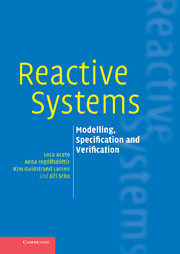Book contents
- Frontmatter
- Contents
- Figures and tables
- Preface
- I A Classic Theory of Reactive Systems
- II A Theory of Real-time Systems
- 8 Introduction
- 9 CCS with time delays
- 10 Timed automata
- 11 Timed behavioural equivalences
- 12 Hennessy–Milner logic with time
- 13 Modelling and analysis of Fischer's algorithm
- Appendix A Suggestions for student projects
- References
- Index
8 - Introduction
from II - A Theory of Real-time Systems
Published online by Cambridge University Press: 17 March 2011
- Frontmatter
- Contents
- Figures and tables
- Preface
- I A Classic Theory of Reactive Systems
- II A Theory of Real-time Systems
- 8 Introduction
- 9 CCS with time delays
- 10 Timed automata
- 11 Timed behavioural equivalences
- 12 Hennessy–Milner logic with time
- 13 Modelling and analysis of Fischer's algorithm
- Appendix A Suggestions for student projects
- References
- Index
Summary
Real-time reactive systems
In the first part of this book, we motivated and developed a general-purpose theory that can be used to describe, and reason about, reactive systems. The key ingredients in our approach were:
an algebraic language, namely Milner's CCS, for the syntactic description of reactive systems;
automata, e.g. labelled transition systems (LTSs), for describing the dynamic behaviour of process terms;
structural operational semantics allowing us to associate systematically an LTS with each process term in a syntax-directed fashion;
notions of behavioural equivalence for the comparison of process behaviours; and
modal and temporal logics to specify desired properties of reactive systems.
These ingredients gave the foundations for the formal modelling and verification of reactive systems and are the bedrock for the development of (semi-)automatic verification tools for reactive systems.
The theory that we have developed so far, however, does not allow us to describe naturally all the important aspects in reactive computation. Consider, for instance, some, by now ubiquitous, examples of reactive systems, namely embedded systems like the ABS and air bags in cars, cruise-control systems, digital watches, mobile phones, computer monitors, production lines and video-game consoles. These are all examples of real-time systems. A real-time system is a system whose correct behaviour depends not only on the logical order in which events are performed but also on their timing.
- Type
- Chapter
- Information
- Reactive SystemsModelling, Specification and Verification, pp. 159 - 160Publisher: Cambridge University PressPrint publication year: 2007

